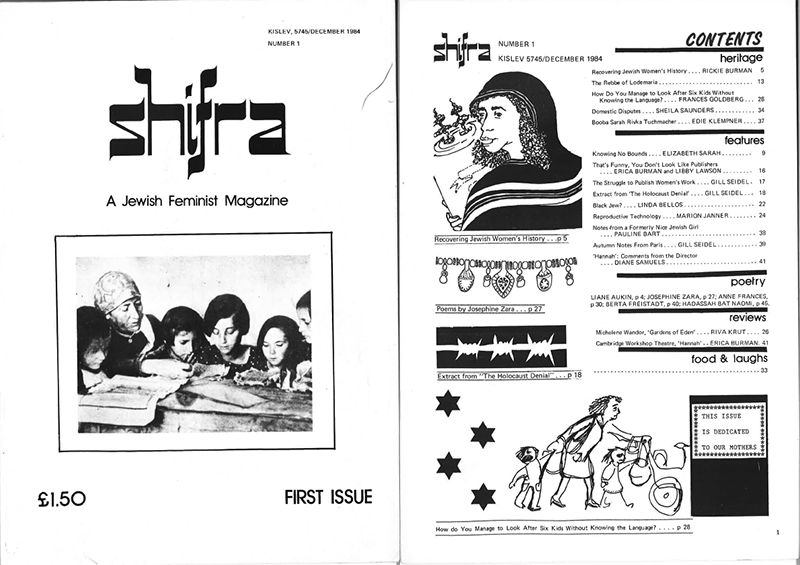‘Shifra’: A Voice for Jewish Feminists

Leeds was something of a hot-bed of Jewish radicalism in the 1980s, hosting the Ruach ‘alternative’ conference and seeing the establishment of JONAH (Jews Organised for a Nuclear Arms Halt and the beginnings of JCORE (Jewish Council for Racial Equality). Jewish women’s issues were particularly at the fore with the formation of Jewish Women’s Aid to assist victims of domestic violence and the publication of the magazine Shifra, a voice for Jewish feminists. This image of the front cover and contents page of the first edition of Shifra is today’s Hidden Treasure. Karen Sayers from Leeds University Special Collections, examines Shifra further:
Founded in 1984, ‘Shifra’ magazine gave a voice to Jewish Feminists. The editors aimed to create ‘a Feminist home in the Jewish community and a Jewish home in the Feminist community’.1 ‘Shifra’ challenged how people outside the Jewish community perceived Jews, particularly women. Four issues were published from 1984-1986.
The editors of ‘Shifra’ encouraged their readers to contribute material about every aspect of their lives. The content included articles, biographies, poems, recipes and photographs and ranged over contemporary and historical material. While not rejecting women’s traditional role in the Jewish community the magazine discussed how it could be modernised and made more racially and sexually inclusive.
Many articles concern women’s relationships with the Jewish religion. In ‘Knowing no bounds’ Elizabeth Sarah explores her experience as a Jew and lesbian and her attempts to reconcile her religion and sexuality. She writes about a feminism which is far from welcoming of diversity. This allows women to be Jewish in a cultural but not a religious sense.2 In ‘Why I am not a Jewish feminist’ Dena Attar describes the suffering of Jewish women who in the name of religion are confined to particular familial roles and whose rights within the family are restricted. Attar’s feminism supports women trying to gain freedom from religious oppression be it Jewish, Catholic or Islamic.3
Many writers challenge the male dominated history of the Jews. They describe the experiences of their foremothers to recover women’s voices. Hedi Argent examines the life of her mother, Liza, praising her strength and determination. In the 1930s, Liza persuaded the Nazis to release her husband from prison.4 Another author recalls ‘The Rebbe of Lodemaria’. Born in 1815 she is a rare, perhaps unique, example of a woman who was a rabbi in the 19th century.5
‘Shifra’ contains recipes and articles about traditional food from different Jewish cultures. Food has always been an outlet for Jewish women’s creativity and a way of participating in the Jewish religion. The editors embrace this as part of their modern identity. Traditionally women were responsible for the health of the body, and men for that of the mind. Many women ran Jewish shops, bakeries and businesses before coming to the UK and some started again in their new home.
After two issues ‘Shifra’ had not fulfilled the editors’ aims. In the editorial to Number 3 they comment that too many of the articles they receive are historical. They ask contributors and readers to analyse current events and take ‘a more active role than the passive consumers of the present’.6 It is possible their request was not successful as the 4th issue of the magazine was the last.
Most of the ‘Shifra’ papers held at Leeds Special Collections are in the Marilyn Fetcher Collection in the Feminist Archive North. The archives include copies of the magazine, typescript proofs of articles and letters to, and from, the editors. There is a complete set of magazines in ‘Shifra’: A Jewish Feminist Magazine.
1 Shifra, Number 1, Kislev 5745/December 1984, p.2 http://www.rainbowjews.com/wp-content/uploads/2013/05/Shifra-vol-1.pdf <accessed 7 Oct 2020>
2 Shifra, Number 1, Kislev 5745/December 1984, pp.9-12 http://www.rainbowjews.com/wp-content/uploads/2013/05/Shifra-vol-1.pdf <accessed 7 Oct 2020>
3 Shifra, Number 2, Shavuot 5745/May 1985, pp.8-10 http://www.rainbowjews.com/wp-content/uploads/2013/05/Shifra-vol-2.pdf <accessed 7 Oct 2020>
4 Shifra, Number 2, Shavuot 5745/May 1985, p.35 http://www.rainbowjews.com/wp-content/uploads/2013/05/Shifra-vol-2.pdf <accessed 7 Oct 2020>
5 Shifra, Number 1, Kisleve 5745/December 1984, p.13 <accessed 7 October 2020>
6 Shifra, Numbers 3 and 4, Chanukkah 5747/Dec 1986, inside front cover <accessed 12 Oct 2020>
Discover more Hidden Treasures
Hidden Treasures: Celebrating the documents, photos and artefacts in British archives that tell the story of Jews in Britain